Ashwin Prabhu, together with Nithya V and the rest of the team at Tulika, has created a new book on Mamallapuram or Mahabalipuram. The book introduces us to Mamallapuram by walking us through the place and telling us stories connected with its architecture and structure. It also raises important questions about the place of art in history.
Ashwin looks at Mamallapuram not as an ancient place but as a friend. His high level of interest on the subject too comes across. These help in making the reader rise in love with both – Mamallapuram and sculpture art.
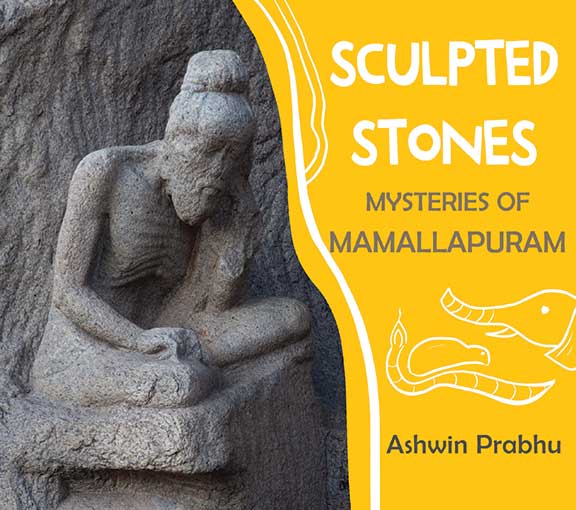
Sculpted Stones – Mysteries of Mamallapuram
By: Ashwin Prabhu
Photographs: Nithya V
Publisher: Tulika
First published: 2023, India
Price: Rs. 365/-
ISBN: 978-81-960332-4-8
Teacher Plus had a few questions for Ashwin after reading the book.
Teacher Plus: First of all – how did the book come about? How would you want it to be used / read? Did you discuss the idea / details / draft with children?
Ashwin: Looking back, the groundwork for this book possibly happened over the several school trips to Mamallapuram I went on with the class 8 students, as their teacher in The School KFI, Chennai. I would ask students to pick one monument each, read a little about it, but more importantly visit it with their parents to experience it first-hand in a very physical sense, and then present it to their classmates as a docent (volunteer guide) when we would finally visit the place on our trip. And what I observed on these trips was that while some students had a head for facts and years and names of kings and thrived on this, most were somewhat put off when there was an undue emphasis on the ‘knowledge’ or informational aspects of the place. Conversely, it was the little observational details in the sculptures which caught their eye – the bend of a leg, the bulge in the eyes of a mouse, a line of mysterious grooves on a rock – and got them to engage with the historical artwork all around them in this seaside town.
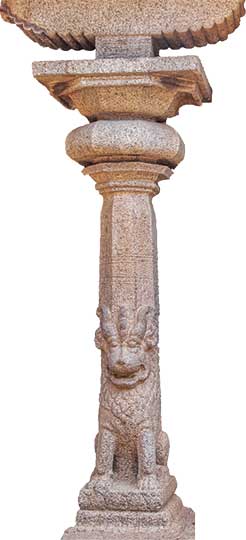
This really is the basis for this book – that first-hand observation, description, and imagination can be excellent entry-points for children to engage with history and art, and can lead them down a trail of exploratory learning. However, having said that, to get children to slow down and to patiently observe something requires a little bit of structure. This book illustrates how educators can provide that structure – an opening question, a little visual cue, a simple worksheet – all of these can help bring about attention and focus in a child. So, I can imagine the book being put to use in a variety of ways – perhaps as a field guide for parents and children, maybe as preparatory text for a teacher taking a group of students out to a site of historical interest, a storytelling aid for a heritage walk and so on.
Children have very much been part of the creative process which has led to this book, though both they and I did not perhaps realize it when it was happening. Many of the questions posed in the book are those which were first raised by the children on the trips, the suggestion that this style of pedagogy could actually be a book came from a teacher colleague of mine, and the photographs for the book have been shot by a former student of mine. So, in many ways, this book has been a collective enterprise.
Teacher Plus: Why did you opt for this format (size/pages/images)? Why did you not go for fiction? Most of our children, today, are neither going to sculpt nor are they going to read the Mahabharat, so why talk about this art at all?
Ashwin: To the question, “Why not fiction”, my response would be that this book is very much a product of the teaching-learning processes practiced in a school setting. To that extent, the attempt has been to address the subject matter head-on, by putting the viewer in direct touch with the artwork, and so this work has taken this shape of a non-fiction book.
I am not so sure about the part of the question which assumes that children are not going to sculpt or read the Mahabharata. Sure, not too many children are going to literally sculpt stone, but many are going to be involved in acts of artistic creation – writing, composing, designing, performing, and so on. And I think this art of stone sculpture from several centuries back has something timeless to convey to them in these contemporary times – to work slowly without succumbing to cravings for instant gratification, to hone one’s individual skill without undue reliance on one’s tools, and finally to stay true to an artistic vision with all its grandeur and attention to detail. Similarly, maybe not too many children are going to engage with the Mahabharata as a direct reading exercise, but they are going to look around them and ask questions of the art, architecture, and culture of their land, and in that context, it will be valuable for them to know the literature from which all of this has derived inspiration.
Teacher Plus: Can we talk about arts and history in the same breath? Or, can we talk about history without talking about arts?
Ashwin: A lot of history which is going to be accessible to children in a tangible, visceral manner is the art, sculpture, and architecture of this land – the temples, the mosques, the churches, the forts, the performing art forms. So, at one level, talking about arts and history in the same breath to a child seems like a very natural and intuitive thing to do for a teacher. I would like to think that it is this physical heritage which provides us with the most effective entry point into the study of the subject. Pedagogically, this also means choosing ‘Contact’ over ‘Content’ and that I think is the approach we need to take to get more children to engage with the social sciences. As for talking about ‘history without the arts’, I do admit that there is a place and time for that, but that is probably best kept for a later stage of engagement once the child is ready and willing.
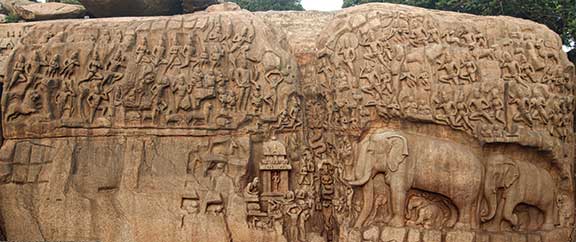
Teacher Plus: Are our epics the crucial link to understand and learn about our history and arts? A link that we are slowly losing?
Ashwin: I see the epics as marvellous sociological mega-narratives with strands of history, religion, politics, culture, ethics, and philosophy embedded in them. To introduce children to the epics in a light, yet contextual manner is to open up the potential for a life-long journey of exploration for them. And so, the teacher in me will always vote for their use in the pedagogical process. In literature, there is the scope for both inward and outward looking, and both of these are equally valuable in education. As teachers, in presenting these epics to children, if we can creatively yet authentically show real linkages that exist with their lived experiences, then I think we have little to fear of losing our connections with the past.
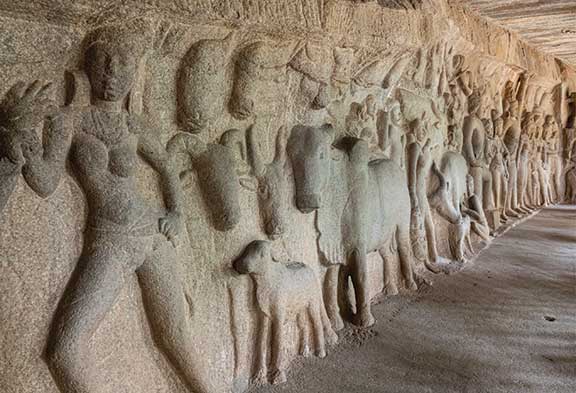
Teacher Plus: The text has a very clear tone. There is an absence of certainty, i.e., multiple options and doubts are conveyed. Also, not only is information overload absent but there is also a message that we do not have responses to all questions. How conscious was this? Has this got to do with pedagogy?
Ashwin: Well, I think what helped set the tone for the book quite clearly was the fact that on certain aspects of Mamallapuram’s history and art at least, there is a lack of consensus amongst scholars and researchers. This multiplicity of theories then naturally forms the basis for the ‘mystery’ in the book and therefore the tentativeness in articulation. But, also pedagogically speaking, this was a conscious choice. By stating upfront that there are certain questions to which we don’t have answers yet, we immediately empower children to construct responses of their own fuelled by their own sense of imagination, while still guiding them to tread carefully and stay within the realm of historical possibility. Also, an insistence from the teacher that imagination cannot become a free flight of fantasy but has to be rooted in real-world observation and accurate description helps in making this a constructive exercise in critical thinking for the student.
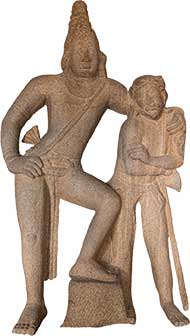
Teacher Plus: Continuing with pedagogy – would you want to elaborate on these statements from the book?
• As teachers of history or art, we often lay emphasis on ‘knowledge’ and ‘technique’. But when we move away from this conventional approach, we can free children from the fear of being wrong. Inviting them to observe, ask questions and attempt to construct logical answers to their own questions can help them engage with the subject.
• Art, however magnificent, when created, is never immortal. It needs the continuous respect, love and care of every subsequent generation for it to endure. And those working with young minds and hearts have a very special role to play in this effort.
Ashwin: I think I have already touched on these statements from the book in some fashion during the course of this conversation, but I’ll attempt to very briefly expand on these ideas.
As teachers, we may have often noticed that history tends to get interpreted as a ‘bundle of names and facts’ and art as something which is ‘only for the skilled few’ by our students. The sub-text to this is of course the unfortunate notion amongst students that these subjects are not for everyone. I think it is vital that as teachers we are able to come up with engagement models for children in their formative years of learning which keep them ‘hooked’ to a subject without feeling inadequate. This book attempts to present one such approach for the intersection of history and art which makes the subject equally available to every child.
Finally, on the note of ‘art however magnificent when created, is never immortal’, I think this is a significant message to communicate to young audiences in today’s world. Children are growing up in an age where very little is long-lived: self-destructing messages (and artworks!), ‘use and throw’ garments (and appliances!) and rapidly changing interests (and opinions!). In such an age, to recognize and appreciate ‘permanence’, especially when it is so rare becomes important. But at the same time, this ‘permanence’ cannot be taken for granted. This ‘permanence’ in art at least has only been possible because of a multi-generational respect and care. And that is something our children need to recognize and value and carry forward.
